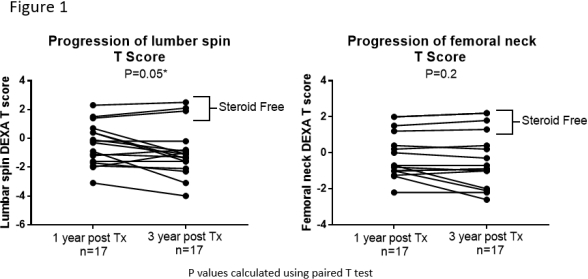Progression of Vertebral Bone Disease among Kidney Allograft Recipients on Steroid Maintenance
E. Abuhelaiqa,1 M. Alkadi,1 M. Jarman,2 J. Mahmoud,2 A. Hamdi,1 A. Ashor,1 A. Nauman,1 M. Asim,1 O. Fituri,1 H. Al-Malki.1
1Nephrology-Internal Medicine, Hamad Medical Coperation, Doha, Qatar
2Transplantat Surgery, Hamad Medical Coperation, Doha, Qatar.
Meeting: 2018 American Transplant Congress
Abstract number: A227
Keywords: Kidney transplantation, Osteoporosis
Session Information
Session Name: Poster Session A: Kidney: Cardiovascular and Metabolic
Session Type: Poster Session
Date: Saturday, June 2, 2018
Session Time: 5:30pm-7:30pm
 Presentation Time: 5:30pm-7:30pm
Presentation Time: 5:30pm-7:30pm
Location: Hall 4EF
Background
Osteoporosis has been recognized as a significant cause of morbidity post kidney transplantation. We aimed to evaluate the prevalence of osteoporosis at one year post renal transplant, evaluate progression at 3 years post-transplant and determine its risk factors.
Methods
47 renal graft recipients identified (mean age:48, 38% females) who were transplanted between 2011 to 2015 and had bone mineral densitometry (DEXA) at one-year post transplant followed at our center. Among those, 17 recipients had follow up DEXA scan at 3 years. 82% of recipients were on steroids post-transplant. We evaluated progression of bone mineral density at one and three years. Furthermore, we investigated the correlation of DEXA T scores to vitamin D 25, parathyroid hormone (PTH), calcium, phosphorus and creatinine at transplant, one year and three years.
Results
The prevalence of osteoporosis at one-year was 17% (8 of 47 recipients) and incidence of 6% at year three post kidney transplant. Osteoporosis was more common in females (P=0.03), but not associated with age, donor type, or induction therapy. PTH at one year, but not at transplant, was inversely correlated with one year lumbar spine T-scores (r=-0.4 [CI:-0.7 to -0.1]P= 0.02). There was a worsening of lumbar spine T-scores (P=0.05), but not femoral T-scores (P=0.2) at 3 years follow up (figure 1). This progression was only seen among recipients on steroid maintenance (P=0.003).
Conclusion
Frequent screening by radiologic and metabolic studies may expedite early treatment of bone disease among kidney transplant recipients. Furthermore, use of steroid free regimen may improve progression of osteoporosis among post-menopausal and persistent hyperparathyroidism recipients.
CITATION INFORMATION: Abuhelaiqa E., Alkadi M., Jarman M., Mahmoud J., Hamdi A., Ashor A., Nauman A., Asim M., Fituri O., Al-Malki H. Progression of Vertebral Bone Disease among Kidney Allograft Recipients on Steroid Maintenance Am J Transplant. 2017;17 (suppl 3).
To cite this abstract in AMA style:
Abuhelaiqa E, Alkadi M, Jarman M, Mahmoud J, Hamdi A, Ashor A, Nauman A, Asim M, Fituri O, Al-Malki H. Progression of Vertebral Bone Disease among Kidney Allograft Recipients on Steroid Maintenance [abstract]. https://atcmeetingabstracts.com/abstract/progression-of-vertebral-bone-disease-among-kidney-allograft-recipients-on-steroid-maintenance/. Accessed December 12, 2025.« Back to 2018 American Transplant Congress

